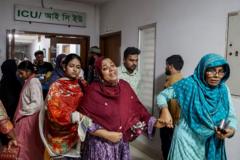What Happened in the Deadly Bangladesh Jet Crash at a School?

Understanding the Tragic Military Jet Crash in Dhaka, Bangladesh
The recent military jet crash in Dhaka, Bangladesh, has left the nation in mourning as it marks one of the most devastating aviation disasters in decades. With at least 27 people, including many students, losing their lives, the incident raises important questions about aviation safety and emergency preparedness. This article delves into the details of the crash, the aftermath, and the broader implications for the region.
The Incident: A Timeline of Events
On the afternoon of the crash, an F-7 military jet took off from a Bangladesh Air Force Base around 13:06 local time (07:06 GMT). Shortly after takeoff, the aircraft reportedly experienced a mechanical failure, prompting the pilot, Flight Lieutenant Md. Taukir Islam, to attempt an emergency landing in a less populated area. Tragically, the jet crashed into the Milestone School and College, located in the Uttara neighborhood of Dhaka.
Witnesses described a scene of chaos and devastation as the jet collided with the building. A teacher at the school recounted hearing an explosion, followed by a rush of fire and smoke. Eyewitness accounts reveal that many victims were either students leaving school or parents waiting for their children to finish classes.
The Victims and Immediate Impact
Of the 27 confirmed dead, at least 17 were children enrolled at the Milestone School and College, which serves approximately 2,000 students from pre-school to senior secondary levels. The tragic loss of young lives has sent shockwaves through the community, with many families devastated by the sudden and violent nature of the incident.
The aftermath of the crash saw emergency responders working tirelessly to sift through the wreckage for survivors. Reports indicated that over 170 individuals were injured, many suffering from severe burns caused by jet fuel. Hospitals in the area, including the Uttara Adhunik Medical College Hospital and the National Institute of Burn and Plastic Surgery, became overwhelmed with patients and family members seeking information about their loved ones.
Government Response and Investigation
In response to the tragedy, the Bangladeshi government has taken swift action. An investigation committee has been established to determine the cause of the crash, and authorities have promised to ensure that all necessary assistance is provided to the victims' families. The leader of Bangladesh's interim government, Muhammad Yunus, has emphasized the importance of identifying the deceased and ensuring proper care for the injured.
Yunus also urged the public to avoid overcrowding hospitals to facilitate medical efforts. As the nation grieves, leaders from neighboring countries, including Pakistan and India, have extended their condolences, highlighting the regional impact of such tragedies.
Aviation Safety in Bangladesh: A Historical Perspective
Plane crashes are relatively rare in Bangladesh, especially in recent decades. The last significant aviation disaster occurred in 1984, when a Biman Bangladesh Airlines flight crashed while attempting to land, claiming all 49 lives aboard. Since then, the aviation sector has seen improvements, but incidents like the recent crash raise concerns about the safety protocols in place, particularly for military training flights.
In 2018, another tragic incident involving a US-Bangla Airlines flight resulted in 51 fatalities in Nepal, highlighting the ongoing challenges faced by the aviation industry in the region. Meanwhile, a training jet crash in 2008 near Dhaka claimed the life of its pilot, underscoring the inherent risks associated with military aviation.
The Human Cost of the Tragedy
The human impact of the crash extends beyond the immediate loss of life. Families are left grappling with the emotional and psychological ramifications of the tragedy. A Year 10 student, Farhan Hasan, shared his harrowing experience of witnessing his best friend's death in the crash. Such stories of loss resonate deeply within the community, as parents and guardians mourn the senseless loss of young lives.
The emotional toll is further compounded by the injuries sustained by many survivors, predominantly children aged 10 to 15 years old. Medical professionals have reported that a significant number of these young victims are facing critical conditions due to burn injuries, raising urgent questions about the adequacy of medical resources and support systems.
Community Response and Solidarity
In the wake of the tragedy, the community has come together in solidarity. Many citizens have stepped forward to donate blood for the injured, and volunteers have rallied to support affected families. Politicians and local leaders have also visited hospitals to offer their condolences and assistance.
This sense of unity and resilience highlights the strength of the Bangladeshi people in times of crisis. However, it also raises questions about the preparedness of the government and health services to handle such large-scale emergencies in the future.
Looking Ahead: Ensuring Safety and Preventing Future Tragedies
The tragic loss of life in the Dhaka jet crash serves as a critical reminder of the need for stringent safety measures in aviation, particularly concerning military operations. As investigations proceed, it will be essential for authorities to identify not only the immediate causes of the crash but also any systemic issues that may have contributed to this disaster.
Improving safety protocols, enhancing pilot training, and ensuring proper maintenance of aircraft are all crucial steps in preventing similar incidents in the future. Additionally, the government must address the psychological and emotional needs of the affected families and communities to foster healing and resilience.
Frequently Asked Questions
What caused the military jet crash in Dhaka?
The military jet crashed after reportedly experiencing a mechanical fault shortly after takeoff. The pilot attempted to steer the aircraft to a less crowded area but unfortunately collided with a school building.
How many people were killed in the crash?
At least 27 people lost their lives in the crash, including many young students who were leaving school at the time.
What measures are being taken to investigate the crash?
The Bangladeshi government has formed an investigation committee to examine the circumstances surrounding the crash and identify contributing factors. They are also ensuring assistance for the affected families.
How has the community responded to the tragedy?
The community has come together to support victims and their families, with many volunteering to donate blood and offering assistance. Local leaders and politicians have also expressed their condolences and support.
Conclusion: A Call for Reflection and Action
The tragic events surrounding the military jet crash in Dhaka will resonate in the hearts of many for years to come. As the nation mourns, it is crucial to reflect on the lessons learned and prioritize safety measures to prevent future disasters. The community's resilience and solidarity in the face of such adversity highlight the strength of the Bangladeshi people. Moving forward, how can we ensure that the sacrifices made in this tragedy lead to meaningful changes in aviation safety and emergency preparedness? #Bangladesh #AviationSafety #CommunitySolidarity
Published: 2025-07-22 04:28:08 | Category: technology



